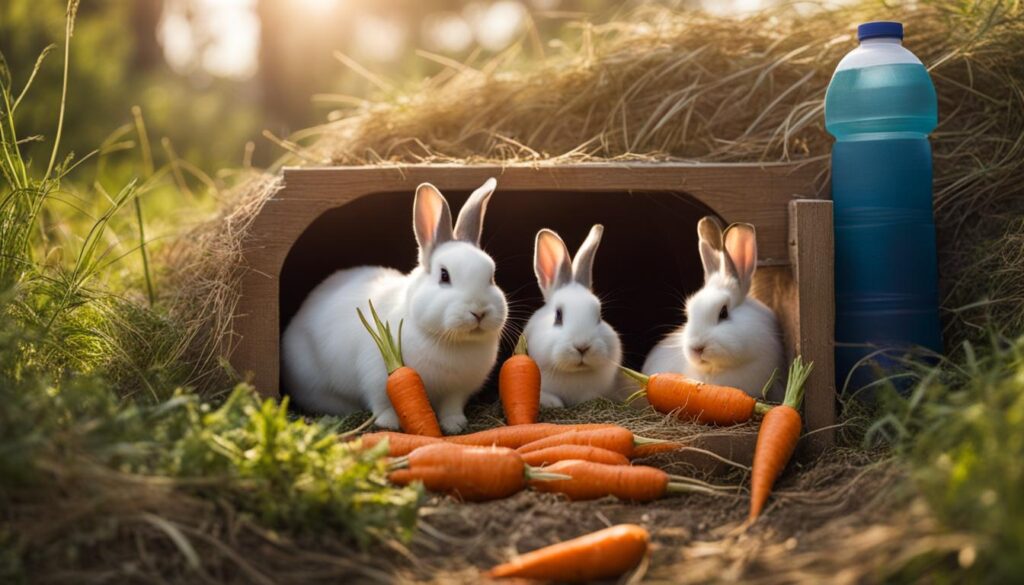Rabbit breeding can be a rewarding and fulfilling experience for those who are new to it. However, it requires appropriate knowledge and guidelines to ensure success and a thriving rabbit population.
As a first-time rabbit breeder, it is crucial to understand important aspects of rabbit care such as habitat setup and nutrition. Additionally, proper breeding and reproduction techniques must be followed, and preventive measures must be taken to maintain the rabbits’ health.
Key Takeaways:
- Setting up a proper habitat is crucial for rabbits’ well-being.
- Choosing the right breeding pair is a significant factor in successful breeding.
- Proper nutrition and feeding requirements must be followed.
- Regular monitoring and preventive measures should be taken to maintain the rabbits’ health.
- Handling newborn kits and providing a nurturing environment is essential for their growth and development.
Setting Up the Ideal Habitat
Creating the ideal habitat for rabbits is essential for their health and well-being, especially for those that are being bred for the first time. In this section, you will find beginner-friendly rabbit breeding advice to help you set up the perfect habitat for your rabbits.
Cage Size and Setup
It is important to provide enough space for your rabbits to move around freely. A general rule of thumb is to have a cage that is at least four times the size of your rabbit. For example, a medium-sized rabbit should have a cage that is at least 4 feet long, 2 feet wide, and 2 feet high. You can use a wire cage or a wooden hutch, but make sure it is big enough for your rabbits to stretch and hop around.
Add a solid floor to the cage to prevent your rabbits from getting sore hocks. Cover the floor with a generous amount of bedding, such as hay or straw, to keep your rabbits dry and comfortable.
Temperature and Lighting
Rabbits are sensitive to temperature changes, so make sure their habitat is in a cool, dry, and well-ventilated area. Keep the temperature between 60 and 70 degrees Fahrenheit and avoid exposing them to direct sunlight or drafts.
Provide sufficient lighting for your rabbits to see and move around comfortably. A 12-hour light/dark cycle is recommended, but make sure there are shaded areas available for your rabbits to rest.
Nesting Boxes
If you are breeding rabbits, provide nesting boxes for your female rabbits to give birth and nurse their kits. The boxes should be large enough for the female rabbit to turn around and have a separate area for the kits to nurse. Place some soft bedding inside the box to keep the kits warm and comfortable.
Cleanliness and Maintenance
Regular cleaning and maintenance are crucial for keeping your rabbits healthy and comfortable. Clean their cages and replace their bedding at least once a week, and spot clean any soiled areas daily. Monitor their habitat for any signs of damage or wear and tear, and repair or replace anything that needs attention.
By following these important rabbit husbandry tips, you can ensure a comfortable and safe environment for your rabbits, making the breeding process much more successful and fulfilling.
Selecting the Right Breeding Pair
Choosing the right breeding pair of rabbits is crucial for a successful breeding experience. There are several factors to consider when selecting the breeding pair.
Breed Compatibility: Ensure that the breeding pair is of the same breed or a compatible breed to produce healthy and genetically sound kits. Breeding different breeds can result in offspring with undesirable traits or health issues.
Health: Both rabbits should be in good health with no visible signs of illness or disease. This includes checking for any discharge from the eyes, nose, or mouth, and ensuring that the rabbits have no injuries or abnormal growths.
Temperament: It is essential to choose rabbits with compatible temperaments to ensure a successful breeding experience. Rabbits with aggressive or anxious behavior may not mate or can harm each other.
Age: Female rabbits should be at least six months old and male rabbits at least four months old before breeding. Breeding them before they reach this age can cause health issues and may result in unsuccessful mating.
Introducing the breeding pair should be done carefully and gradually to prevent any aggressive behavior. It is recommended to introduce them on neutral territory and to supervise their interactions closely.
Best Time for Breeding
The best time for breeding is when the female rabbit is in heat, which usually occurs every 14-16 days. It is important to monitor the female rabbit’s behavior and body language, which can indicate when she is in heat. Signs of heat include restlessness, increased appetite, and a willingness to mate.
During the breeding process, it is recommended to keep the pair in a quiet and calm environment to reduce stress and increase the chances of successful mating.
By following these beginner-friendly rabbit breeding tips and successful rabbit breeding techniques, first-time rabbit breeders can ensure that they select the right breeding pair for a healthy and happy litter of kits.
Nutrition and Feeding Guidelines
Proper nutrition and feeding are crucial for the health and well-being of breeding rabbits. It is essential to understand their dietary requirements and feeding schedules to ensure a balanced and nutritious diet.
Dietary Requirements
Breeding rabbits need a diet rich in protein and fiber to support their reproduction and growth. They require a minimum of 16% protein and 18% fiber in their diet. A mix of hay, pellets, fresh vegetables, and fruits is recommended for a balanced diet.
| Food Type | Quantity | Frequency |
|---|---|---|
| Hay | Unlimited | Daily |
| Pellets | 1/4 cup per 5lbs of body weight | Daily |
| Vegetables | 1-2 cups | Daily |
| Fruits | 1-2 tablespoons | Weekly |
It is important to introduce new food gradually and observe any signs of digestive problems or allergies. Avoid feeding them with high-fat and sugary foods, as they could lead to obesity and health issues.
Feeding Schedule
Breeding rabbits should be fed twice a day to maintain their health and energy levels. The first feeding should be in the morning, and the second feeding should be in the evening.
- Hay should be available at all times and replaced daily.
- Pellets should be given in small portions to avoid overeating and obesity.
- Vegetables should be fresh and washed before feeding.
- Fruits should be given in moderation and as a treat.
Water should also be provided at all times and changed daily to ensure cleanliness and freshness.
Following a proper nutrition and feeding schedule is essential to keep the breeding rabbits healthy and productive. Consult with a veterinarian for any concerns or questions regarding their dietary needs.
Monitoring Health and Preventing Diseases
Keeping breeding rabbits healthy is crucial for successful breeding. It’s important to monitor their health regularly to prevent diseases from spreading. Here are some important rabbit husbandry tips to keep in mind:
Regular Check-Ups
Bringing your rabbits to a veterinarian for regular check-ups is important in maintaining their health. It’s recommended to bring them at least once a year. During these appointments, the vet will check their weight, teeth, eyes, and ears. The rabbits will also receive vaccinations for diseases such as rabbit hemorrhagic disease and myxomatosis.
Clean Environment
Maintaining a clean environment is important in preventing diseases from spreading in the rabbitry. Regular cleaning of the cages, feeding areas, and water bottles is recommended. It’s also important to note that rabbits are sensitive to ammonia, so it’s important to keep their living areas well-ventilated.
Healthy Diet
A healthy and balanced diet is important in maintaining the rabbits’ health. Providing them with fresh hay, pellets, and vegetables is necessary. It’s also important to provide them with clean and fresh water daily to prevent dehydration.
Signs of Illness
Knowing the signs of illness is important in catching diseases early. Some common signs of illness in rabbits include loss of appetite, lethargy, discharge from eyes or nose, and changes in behavior. If you notice any of these signs, it’s important to seek veterinary care immediately to prevent the spread of disease.
Following these rabbit breeding tips for monitoring health and preventing diseases will ensure a healthy and successful breeding experience.
Breeding and Reproduction
Breeding rabbits requires careful management, and it is essential to understand the mating behavior of the rabbits for successful breeding.
It is important to introduce the rabbits gradually, allowing them time to get to know each other before attempting to breed. Rabbits can be aggressive towards each other when introduced too quickly, which can result in injuries or even death.
Once the rabbits become comfortable with each other, it is time to introduce the female rabbit into the male’s hutch. It is recommended to breed the female during the evening or early morning when they are most active.
The gestation period for rabbits is around 30 days, and during this time, the female will begin preparing a nest for the kits. The nest should be a warm and comfortable environment to ensure the survival of the unborn kits.
Nesting
The following are some tips to ensure that the nest is ideal for the newborn kits:
- Use soft, warm materials such as hay or straw to create the nest.
- Provide nesting boxes to allow the female rabbit to create a comfortable and secure space.
- Ensure that the nesting area is clean and dry to prevent infections.
- Check the nest daily to ensure that it remains clean and comfortable for the newborn kits.
After the birth of the kits, it is important to give the mother rabbit enough space and privacy to properly care for the newborns. The mother rabbit will nurse the kits for around 4 weeks, and at around 3 weeks, the kits will begin eating solid food.
When the kits are around 6-8 weeks old, it is time to separate the males from the females. This is important to prevent unwanted breeding and to ensure that the rabbits are not overcrowded.
By following these tips for breeding and reproduction, first-time rabbit breeders can successfully breed and care for their rabbits.
Managing Breeding Challenges
While rabbit breeding can be a rewarding experience, there are some challenges that even experienced breeders may encounter. First-time breeders must be prepared for unexpected situations and learn how to overcome them.
Dealing with Aggressive Behavior
Rabbits may display aggressive behavior towards each other, especially during the breeding process. This can be due to various reasons such as territorial disputes or unfamiliarity with their mate. It is important to monitor the rabbits closely and separate them if necessary to prevent injuries.
Breeding Difficulties
Some rabbits may experience difficulty with the breeding process due to factors such as timing or health issues. First-time breeders must consult a veterinarian if they have concerns about the breeding process and seek guidance on how to proceed.
Handling Unexpected Situations
There may be unexpected situations that arise during the breeding process, such as unexpected litters or health issues with the newborn kits. In such cases, it is important to remain calm and seek assistance from a veterinarian or experienced breeder for proper guidance.
To overcome these challenges, first-time breeders must be patient, prepared, and seek the guidance of experienced breeders or veterinarians. By following these tips and guidelines, anyone can become a successful rabbit breeder and raise healthy and happy rabbits.
Weaning and Caring for Kits
Caring for newborn kits requires attention to detail and patience. The weaning process begins when the kits are about four weeks old. During this time, they should be gradually introduced to solid food.
It’s important to handle the kits gently, as they are fragile and their bones easily break. Make sure to wash your hands before handling them to prevent the spread of disease.
Provide a comfortable environment for the kits with soft bedding, but make sure to keep the nest clean and dry. You can use a litter box to collect waste and replace the bedding regularly.
| Feeding Guidelines | Notes |
|---|---|
|
|
As the kits grow, they will become more active and playful. It’s important to allow them to have playtime outside of their cage in a safe, secure area. This will help with their socialization and overall well-being.
Keep a close eye on the kits’ health and behavior. If you notice any signs of illness or injury, seek veterinary care immediately. Regular check-ups are also important to ensure their growth and development are on track.
With proper care and attention, your rabbit kits will grow healthy and strong. By providing a nurturing environment and following these tips, you can ensure a successful rabbit breeding experience.
Tips for First-Time Rabbit Breeders
Starting a rabbit breeding journey can be exciting and challenging for first-time breeders. It is vital to have a comprehensive understanding of rabbit behavior, breeding techniques, and care to ensure a positive experience for both the rabbits and the breeder. These essential tips will guide beginners on how to breed rabbits successfully.
Begin with the Basics
First-time rabbit breeders should start by learning basic husbandry skills such as creating a suitable habitat, feeding, and nutrition. Selecting the right breeding pair is also crucial for a successful breeding experience. It is recommended to consult a veterinarian to ensure the rabbits are healthy and suitable for breeding.
Provide the Ideal Habitat
The ideal habitat for rabbits should be spacious, comfortable, and secure. The rabbit’s habitat should be cleaned regularly, and fresh food and water should be provided daily. It is essential to maintain a suitable temperature, lighting, and humidity level to ensure the rabbit’s well-being.
Select the Right Breeding Pair
The breeding pair should be healthy, compatible, and genetically diverse. It is crucial to observe the rabbits’ temperament and behavior before introducing them. The best time for breeding is between four to six months, and the process of introducing the rabbits should be done gradually.
Provide Proper Nutrition and Feeding Guidelines
The breeding pair should maintain a balanced diet that includes hay, fresh vegetables, and fruits. It is essential to provide food and water in the right amounts and at the proper time to avoid digestive issues. A veterinarian can provide expertise on creating a suitable feeding schedule.
Monitor Health and Prevent Diseases
A healthy rabbit breeding experience requires proper monitoring of the rabbits’ health. Vaccinations, regular check-ups, and observing signs of illness are crucial to prevent the spread of diseases. Proper hygiene practices, such as sanitizing breeding equipment, should also be observed.
Understand Breeding and Reproduction
Understanding the breeding and reproduction process is crucial for successful rabbit breeding. It is essential to observe mating behavior, the gestation period, nesting, and handling newborn kits. The rabbits’ comfort and safety should be a top priority throughout the breeding and reproduction process.
Manage Breeding Challenges
First-time rabbit breeders may encounter breeding challenges such as breeding difficulties or aggressive behavior. It is essential to address these issues immediately and consult a veterinarian or an experienced breeder for advice. Having a contingency plan in place and being proactive can help mitigate these risks.
Weaning and Caring for Kits
Proper weaning and caring for newborn kits are critical to their growth and development. It is essential to provide a nurturing environment, introduce solid foods gradually, and handle the kits with care. Monitoring their health and growth is crucial to ensure their survival.
Rabbit Breeding for Beginners
For beginners, rabbit breeding can be a fulfilling and rewarding experience. Following these essential tips and techniques can help ensure success and a positive experience for both the rabbits and the breeder. By providing proper care, nutrition, and understanding the breeding process, first-time rabbit breeders can have a successful and fulfilling rabbit breeding experience.
FAQ
What is the ideal cage size for breeding rabbits?
The ideal cage size for breeding rabbits should be at least 4 square feet per rabbit. This allows enough space for them to move freely and engage in natural behaviors.
What type of bedding is recommended for rabbit habitats?
It is recommended to use soft and absorbent bedding materials such as straw or wood shavings. Avoid using cedar or pine shavings as they can be harmful to rabbits.
How can I introduce two rabbits for breeding?
To introduce two rabbits for breeding, ensure they are both healthy and gradually introduce them in a neutral territory. Supervise the initial interactions to ensure compatibility before placing them together in a habitat.
What should I feed breeding rabbits?
Breeding rabbits require a balanced diet consisting of high-quality hay, fresh vegetables, and commercial rabbit pellets. Make sure to also provide them with a constant supply of fresh water.
How often should I schedule veterinary check-ups for breeding rabbits?
It is important to schedule regular veterinary check-ups for breeding rabbits at least once a year. This allows for early detection and prevention of any potential health issues.
How long is the gestation period for rabbits?
The gestation period for rabbits is approximately 28 to 31 days. During this time, the pregnant doe should be provided with a suitable nesting area for birthing.
What should I do if breeding rabbits exhibit aggressive behavior?
If breeding rabbits exhibit aggressive behavior, it is important to separate them immediately to avoid injuries. Consult a veterinarian or a rabbit behavior specialist for further guidance on resolving the aggression.
When should I start weaning the kits?
Kits can start being weaned from their mother’s milk at around 4 to 6 weeks of age. Offer them small amounts of hay and gradually introduce solid foods to ensure a smooth transition.





